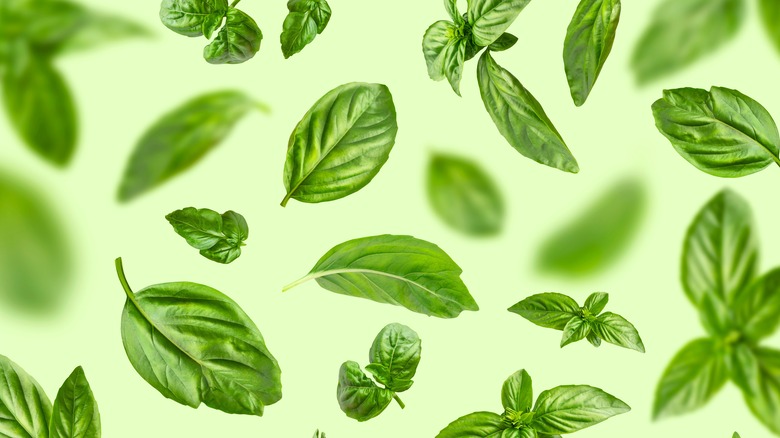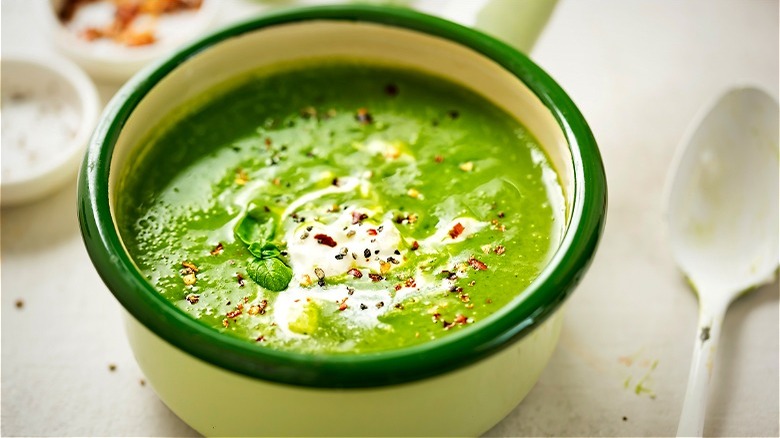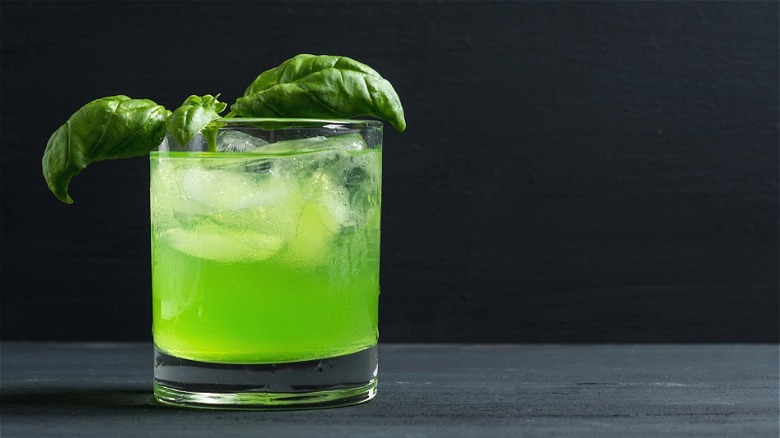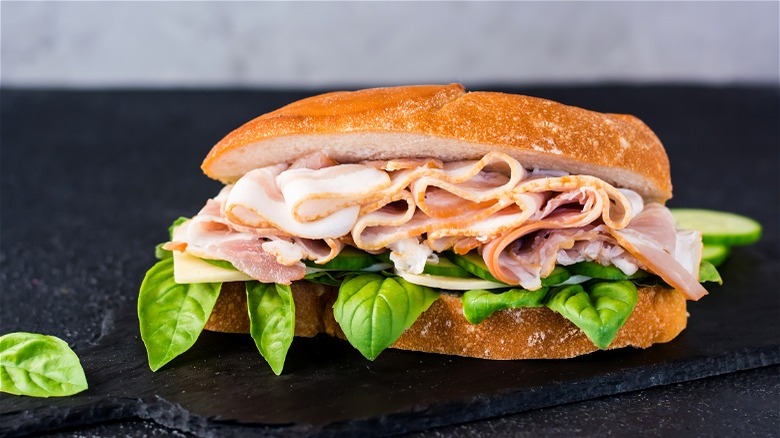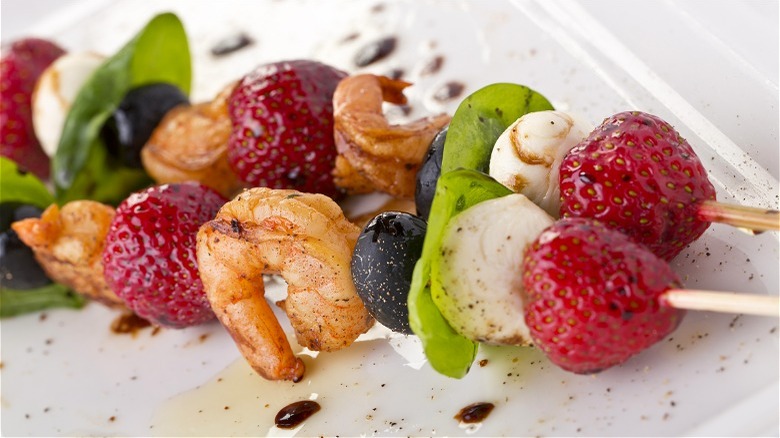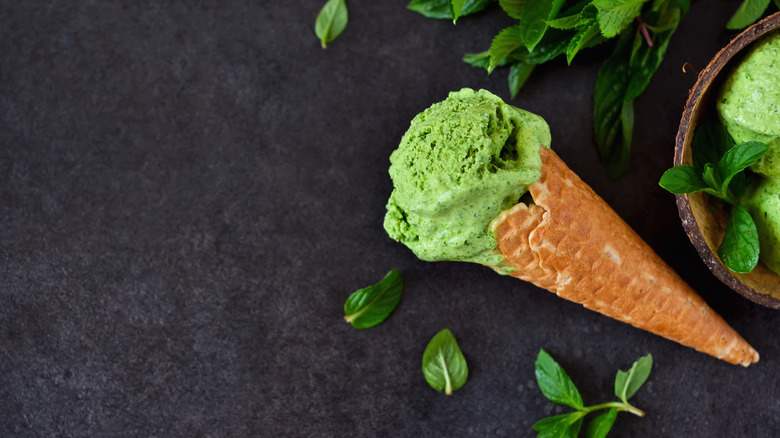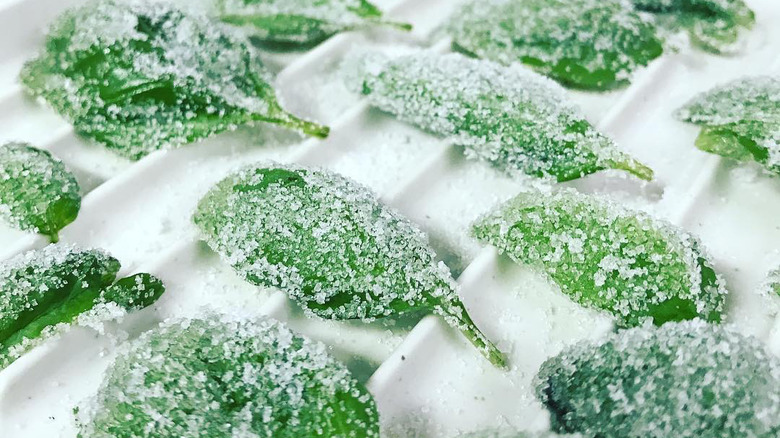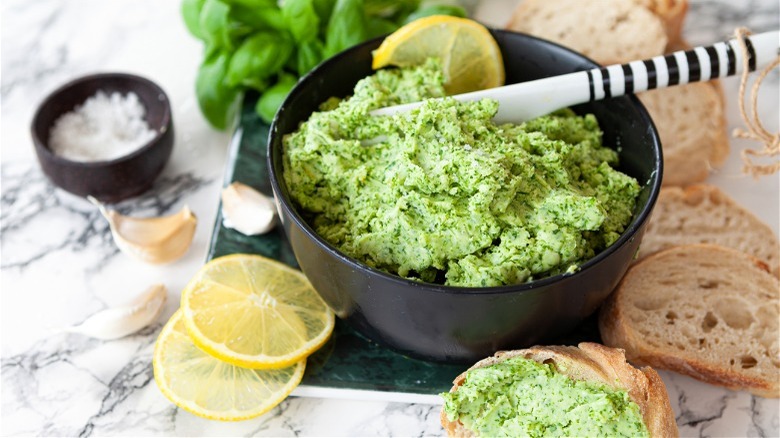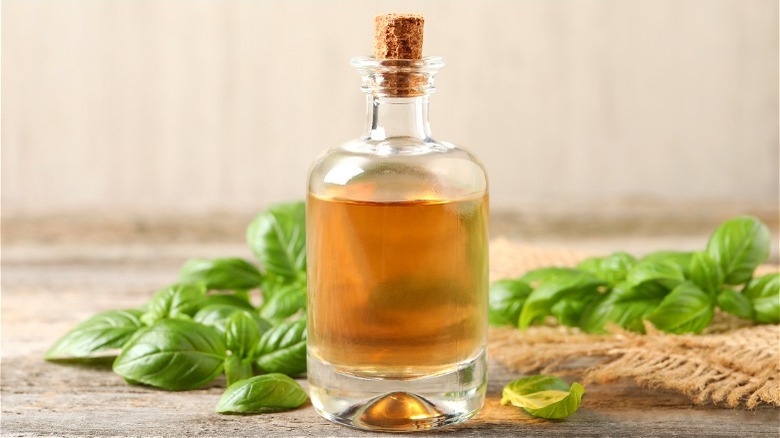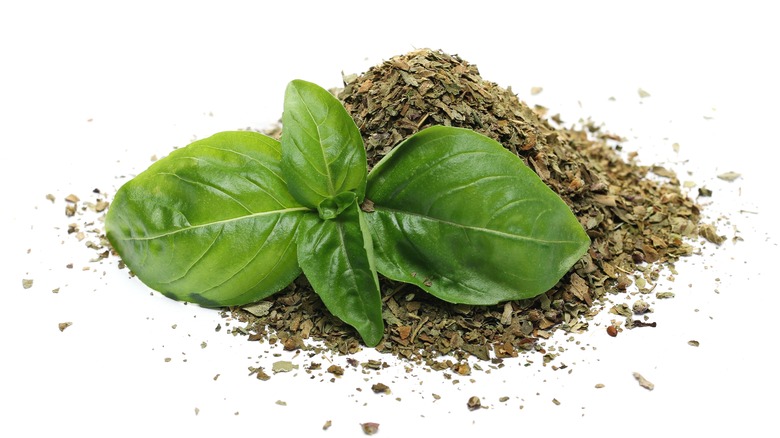10 Unique Ways To Use Fresh Basil
Basil is a flavorful and aromatic herb. Its iconic flavor is often described as sweet and savory, with hints of pepper and mint. It's unlikely that basil will go unnoticed in a dish, and not just because of how it tastes and smells. The plant's shiny and cupped leaves are instantly recognizable, as is its vibrant green color. But there are more types of basil out there than you may recognize. Sweet basil and Genovese basil are most common in the U.S. and Italy, for instance, while Thai basil is popular in Southeast Asia. Holy basil is often used for religious and medicinal purposes in Indian culture. No matter which type of basil you encounter, however, it's clear that people all over the world appreciate these delicious, fragrant leaves.
In the U.S., fresh basil is usually associated with Italian food, where the raw leaves are used to make pesto, Caprese salads, pizza, or pasta dishes. Basil leaves are also commonly employed to garnish recipes drawing in other culinary backgrounds, like strawberry feta salad or open-faced toasts. But outside of Italian dishes and savory meals, there are still many more ways to utilize basil.
Whether you're trying to figure out what to do with leftover herbs or all those extra leaves your basil plant is producing, we've got you covered. This herb can be used in desserts, cocktails, beauty products, and more unexpected but wonderful ways. Here are some of the unique ways you can use fresh basil.
1. Mix it into soup
It may at first seem wrong to this herb into soup because fresh basil is often served uncooked. The raw leaves of this plant are simply dropped straight onto the plate for popular applications like Caprese salad. But basil's versatility means it can star alongside cooked items as well. In hot soups, basil can be used as a garnish, where it creates a fresh contrast to the warm liquid below. In cold soups, basil blends right in. Speaking of blending, you can either cook your basil right into a soup, blend it up using your favorite kitchen tool, or place it right on top of your bowl for visual flair before serving.
Basil works so well as a soup accompaniment that it's difficult to think of a recipe where it wouldn't play along with other ingredients. It suits recipes like tomato soup extra well, given how the savory flavor of tomato fits right in with the herbaceous taste of basil. It's not like the two foods haven't been together before, either. Tomatoes and basil are combined in some of the herb's more famous applications, including Caprese salad, margherita pizza, and pasta Pomodoro. We also recommend using basil in cold soups such as gazpacho. You could use tomato again for this dish, or go for a green gazpacho that emphasizes the vibrancy of this ingredient. This green bone broth gazpacho is made with basil, spinach, cucumber, and other fresh produce.
2. Use it to brighten up your cocktails
If you're into cocktails, then you're probably familiar with the use of mint in alcoholic drinks, where the herb is an important ingredient in boozy beverages like mint juleps and mojitos. But mint isn't allowed to hog all the fun. Basil can add an exciting taste, scent, and look to mixed drinks, as well. Its bright, flavor brings a refreshing element to the mix, where it often proves to be a little more subtle than mint. Eating an entire fresh leaf of basil is certainly more pleasant than doing the same with mint, in our opinion. So, if you're going to accidentally drink up one of the leaves in your glass, we'd prefer it be basil.
If you want more direction on how to deploy basil at the bar, you can use this herb to make a luau basil rum cocktail. The recipe uses St. Germain elderflower liqueur, soda water, rum, lime juice, and ice to create a tropical drink with a hint of herbal flavor from the basil. This similar hazel and basil cocktail combines rum, simple syrup, hazelnut liquor, lime juice, ice, and basil leaves to create a drink that highlights the flavor of hazelnuts.
Basil lovers can also create pre-made syrups and other mix-ins with basil so that you are ready to bartend at a moment's notice. This could be a lime-basil cordial, often used to make cocktails like gimlets.
3. Put it in your sandwich
Caprese salads are often converted into sandwiches, such as paninis or grilled cheeses. The combination of mozzarella, basil, tomatoes, and balsamic vinegar is simply too good to keep restricted to just one food form. But many more sandwiches are improved with the addition of basil than the delicious Caprese.
Basil works great in sandwiches for a few reasons. For one, this herb helps add fresh greens to the meal where it's otherwise common to put things like shredded lettuce or spinach in between two slices of bread. These vegetables add a new texture, fresh flavor, and nutrients and basil can do the same. Second, basil is seriously flavorful, helping it stand out more like an allium or other seasoning rather than a bland bit of produce.
If this intrigues you, consider crafting a. green goddess sandwich. Here, green foods are layered in between two slices of bread to create a monochromat but ultimately satisfying meal. Create your own by combining basil with produce and seasonings like avocado, cucumber, chives, and sprouts. Meanwhile, fans of something sweeter should check out this peanut butter, strawberry, and basil sandwich. Or, if you like mayonnaise, mix your basil leaves with the creamy condiment to create a spread that works well in practically any savory sandwich, like an egg, lettuce, and tomato sandwich.
4. Add it to skewers
Basil can also be added to skewers and not just the kind with mozzarella and tomatoes already on them. Its relatively small, round leaves make basil great for this application, where each bite can include some of this herb. Its color is also great for skewers, where you can draw on different colors of foods to create a varied and aesthetically pleasing look on each skewer. However, if you're grilling or baking, you will want to be sure to add your basil after cooking. The delicate nature of these leaves means that they won't be able to withstand the same amount of heat as other ingredients, such as meat.
The herb is used in this pasta skewer recipe, which employs cooked rigatoni, mozzarella, marinara sauce, and basil to create something like pasta on a stick. Of course, basil could also be added to skewer recipes that don't stick to traditional Italian ingredients. Consider combining basil with common skewer ingredients such as shrimp, beef, chicken, lamb, scallops, peppers, onions, or zucchini. One Redditor suggested a classic Caprese-style skewer consisting of tomato, mozzarella, and a kale-basil pesto. They suggested that you could make this upgraded version of Caprese skewers even more exciting by frying the mozzarella, as well as adding meat such as bacon or prosciutto wrapped around the other ingredients.
5. Use it in frozen treats
This savory herb can also become part of a sweet treat, where its slightly herbal flavor adds a touch of sophistication to desserts that would otherwise be completely sweet. It will also make you seem grown up when you allow a bit of green into your treat.
For desserts, basil might be best used in frozen applications, similar to the way it compliments ingredients in cocktails. If you're up to attempting to make something as complex as ice cream, why not get creative and do that with basil? Use an ice cream maker to combine whole milk, basil, sugar, egg yolks, and heavy cream. People who like floral and herbal dessert flavors are bound to like it. "One of the best desserts I had in my entire life was an orange olive oil cake with basil ice cream," said one person on Reddit.
If you need to go dairy-free, there's no need to feel left out, as you can make a basil sorbet. This blueberry basil sorbet combines fresh basil leaves, blueberries, water, sugar, salt, and lemon juice to create the ultimate refreshing dessert. You can even make a basil-flavored granita, a dessert that's like a fancy version of a snow cone. Like sorbets, granitas are also typically dairy-free. Some people even add basil to their smoothies. "I love using basil in combination with red fruits like strawberries and cherries," said a Redditor.
6. Create basil candy
Looking for a truly unique way to use up leftover basil? Simply gather fresh basil leaves, sugar, and a binding agent, like egg whites or vegetable oil. Yes, you're about to make some basil candy.
To make candied basil leaves, start by laying out your washed, dried, and separated leaves. Next, get your binder ready. If you're going to use egg whites, whisk them until they become foamy. Next, coat each leaf in the foamy egg whites or vegetable oil. Then, sprinkle both sides of the leaf with sugar. Finally, let them dry, being sure to avoid the fridge or freezer at this point. Patience is key here, as this step could take hours or even a couple of days, depending on the temperature and humidity of your kitchen.
Once they're ready, you can eat these basil candies on their own or use them as a garnish for any variety of other treats where their unique appearance will shine, like pies, cakes, and cookies. That's because the sugar coating makes the leaves look like they are covered in sparkles. It pairs especially well with fruity desserts made from strawberries or peaches. One Redditor used candied basil leaves as a decorative topper for a homemade lemon tart. The sparkling green leaves created a satisfying color contrast with the glossy, yellow tart. As with fresh basil, not everyone seems to love the taste of candied basil, however, so your reaction may vary.
7. Make it into butter
Having basil butter on hand is a hack for creating an extra special meal or dinner party. You could simply serve the basil-flavored butter with a fresh loaf of bread, or display it as part of a charcuterie spread or trendy butter board. When used with other ingredients, this basil butter will surely increase the complexity of flavors in any dish it touches.
Making basil butter could be simple or relatively difficult, depending on how much effort you'd like to exert in the process. If you wanted to, you could make the entire spread using just two ingredients: butter and basil. For this method, simply combine the two using a blender, food processor, or stand mixer. Or, you can mix the butter by hand if you feel you need the arm workout. If your butter isn't very soft, we recommend using one of the kitchen gadgets first. If you'd like the flavor of your basil butter to be a little more complex, then you can add additional ingredients like garlic, salt, and pepper.
You can use this condiment in recipes such as this grilled chicken with basil butter, where the herbed butter is added to the top of each piece of grilled chicken. This way the spread melts onto the meat, coating the protein in flavor. Basil butter could also be a nice addition to meals that typically play well with butter, such as corn on the cob, mashed potatoes, or seafood.
8. Make a basil oil
Basil oil is another condiment that, once made, will impart a unique herbal flavor to your dishes. To make basil oil, you'll need ice, basil leaves, olive oil, and canola or grapeseed oil. First, blanch the basil by boiling it for a few seconds before transferring the leaves to a bowl of iced water. Next, squeeze all of the excess water out of the leaves. For the last step, blend the oil and basil leaves together using a food processor. The oil will last for about one week.
If you're feeling creative, you can bring in additional ingredients such as red pepper flakes, lemon juice, or garlic. Ultimately, only your creativity and palate limit you, as you can add whatever you like. You might also use exclusively olive oil as the base, though be aware that the distinct flavor of this type of oil will, of course, be part of the final product.
Green-hued basil oil works great for adding pops of both color and flavor to your dish. It also helps to disperse basil flavor more evenly through a dish than whole or processed bits of basil leaves. This makes it convenient for adding to the tops of dishes like stewed butter beans, roasted salmon, or bruschetta. You could even simply serve it as an appetizer by placing the oil in a shallow bowl and serving it with a baguette for dipping.
9. Make beauty products with basil
Basil can be incorporated into your beauty routine by creating homemade cosmetics. The herb has purported benefits for your skin and hair. According to Tom's of Maine, basil can help your skin by acting as a moisturizer, sun protectant, acne treatment, fungus fighter, and wrinkle reducer.
If you have enough extra basil lying around, you can use it in several different skin treatments. You can make an exfoliating basil body scrub using sugar, basil leaves, lime juice, and coconut oil. Make an anti-aging face mask by mixing basil and yogurt. You can also craft a moisturizing face mask by combining the herb with honey. If you have acne, you can make a pimple-fighting basil face mask with basil, lemon juice, and honey. As with most face masks, you'll want to wash these off your skin sooner rather than later.
Homemade hair products made with basil are also easy to make at home. To make a basil hair treatment, all you need is basil and olive oil. After blending the two ingredients, simply rub this pesto-like mixture onto your scalp and let it sit for up to 45 minutes. It may help with scalp dryness.
10. Dry it out to make it last longer
Maybe you've been through every possible use of fresh basil and found that none work right now or you just don't want to try one. Maybe you're about to leave for a vacation and don't have time to cook one more meal. Maybe you just feel the need to stop looking at that beautiful bouquet of green herbs. Whatever the case may be, we have the solution: dry out your fresh basil. This will greatly extend its shelf life. Fresh basil will last up to 10 days when it's stored in the best conditions. But when it's been dried, basil can last one to three years.
You can dry basil using a standard low-heat oven method or use only the microwave. To go the microwave route, simply spread the individual basil leaves out on a paper towel. Put that paper towel onto a plate. Then, cover the basil with another paper towel. Place the whole assembly in the microwave. Heat your herbs for only 15 seconds at a time so you can check after each round to ensure that the paper towel or herbs aren't catching on fire. Your paper towels do not need to be wet to try this method. However, your risk of the paper towels catching on fire increases the longer you heat them. The basil is done when it is dry and easily crumbles when you touch the leaves.
